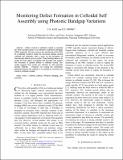| dc.contributor.author | Koh, Yaw Koon | |
| dc.contributor.author | Wong, Chee Cheong | |
| dc.date.accessioned | 2005-12-12T17:34:15Z | |
| dc.date.available | 2005-12-12T17:34:15Z | |
| dc.date.issued | 2006-01 | |
| dc.identifier.uri | http://hdl.handle.net/1721.1/29822 | |
| dc.description.abstract | Defect control in colloidal crystals is essential for these nanostructures to be effective as photonic bandgap (PBG) materials. We have used in-situ monitoring of the PBG of a colloidal crystal to study the structural changes during colloidal self assembly, with a focus on the formation of macroscopic defects such as cracks. These findings allow us to model the final stages of colloidal self assembly and explain the formation of growth defects in colloidal crystal. Our model suggests that cracks are intrinsic to self assembly growth methods. . However, by tuning the interaction potential between the colloids, it is possible to minimize the cracks in colloidal crystals. | en |
| dc.description.sponsorship | Singapore-MIT Alliance (SMA) | en |
| dc.format.extent | 549266 bytes | |
| dc.format.mimetype | application/pdf | |
| dc.language.iso | en | en |
| dc.relation.ispartofseries | Advanced Materials for Micro- and Nano-Systems (AMMNS) | en |
| dc.subject | colloid | en |
| dc.subject | defects | en |
| dc.subject | Photonic bandgap | en |
| dc.subject | Self assembly | en |
| dc.title | Monitoring Defect Formation in Colloidal Self Assembly using Photonic Bandgap Variations | en |
| dc.type | Article | en |
